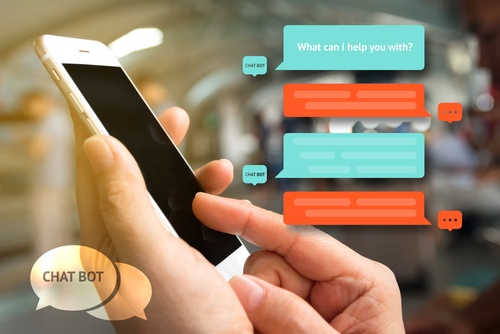
More and more, as customers increase their expectations of brands, they will continue to demand faster responses. Gone are the days when brands had the luxury of waiting a day to respond to an email. In reality, the majority of consumers expect responses to their inquiries in under 10 minutes—across all channels.
This is the first in a two-part series exploring why chatbots are becoming the norm and the core considerations for brands when deciding on a chatbot strategy.
The potential of chatbots in marketing and customer experience strategy is real—one of the primary reasons chatbots are increasingly popular is because of app fatigue. Consumers no longer want to spend time installing new apps; they're spending more and more time on messenger platforms instead. So, many brands are switching to these platforms to connect with consumers.
From the perspective of a brand strategy consultant, before launching your bot experience, first answer a pivotal question to determine what should drive your overarching strategy: Who are you trying to reach with your bot? The most important aspect to keep in mind is to focus on customer needs and experience when you're building it; every function of your chatbot must enhance the customer experience. By viewing things through the eyes of the end user (e.g., their needs based on where they are in the purchase funnel), brands can be strategic in their approach, delivery, and engagement. A branded bot strategy is all about the who.
A Simple Chatbot Strategy
Chatbots learn to recognize the key words, utilize speech analysis and patterns to determine their responses. They're able to access a compiled database of phrases to give a pre-defined response. The sophistication of a chatbot depends on the quality of the pre-determined answer and the ability of a brand to create human-like responses.
When launching a new product or service, brand managers and marketers spend a great deal of time deliberating on product specifications, market size, target audience, projected sales, and distribution channels, before launching. Similarly, when building a chatbot, you need to devote sufficient time contemplating the critical success factors.
Chatbots have enormous potential. But, as with any new technology, brands must carefully consider the implementation challenges that might lie ahead. Here are four basic considerations in getting started:
Ensure consistency. Customers expect a seamless brand experience across all touchpoints and communication channels. A chatbot service must fully integrate with your mobile and web services. What dependencies does your chatbot service have? What new communication paths and protocols need to be established?
Differentiate. As the number of chatbots is set to explode, how do you ensure you stand out in the crowd? How are you unique? What makes your product/service essential compared to your competitors? Deliver targeted content based on user usage, feedback, and interests.
Understand your customers. Chatbot interactions need to be as efficient, short and painless as possible. Ensuring simple interactions and tasks are completed seamlessly is vital. Customers will quickly abandon chatbots that can’t comprehend straightforward inquiries and requests. Even the most advanced chatbots will encounter some complex scenarios they won’t be able to handle. New user experiences will be required. What are your fallback procedures when this happens? How quickly can you shift customers to a human interaction?
Keep it secure. As with all customer-facing technologies, privacy and security are imperative. Security issues should be top of mind from the outset; customers won’t use services they don’t trust with their data.
Chatbots Will Not Replace Humans
Creating a chatbot doesn't have to mean your brand become less human; you're merely engaging people in conversation on the channels they are already on. Chatbots can handle simple queries and support and enable employees to interact with your brand story. They can help us to scale faster to real conversations. In part 2 of our series, we will explore how, working with humans, chatbots can make experiences better.
Recent Posts
Posts by Topics
- Brand Strategy (57)
- Brand Strategy Consulting (28)
- Brand Differentiation (27)
- Customer Experience (24)
- Brand Positioning (22)
- Marketing Strategy (9)
- Brand Extension Strategy (8)
- Customer Behavior (8)
- Brand Architecture Strategy (7)
- Brand Extension (7)
- Brand Growth (7)
- Brand Portfolio & Architecture (7)
- Brand Purpose (7)
- Brand Value Proposition (7)
- Brand Engagement (6)
- Brand Portfolio Strategy (6)
- Brand Storytelling (6)
- Rebranding Strategy (6)
- Brand Awareness (5)
- Brand Image (5)
- Branding (5)
- Rebranding (5)
- Technology (5)
- B2B Brand Strategy (4)
- Brand Experience (4)
- Value Proposition (4)
- Brand Extendibility (3)
- Brand Metrics (3)
- Brand Repositioning (3)
- Corporate Branding (3)
- Differentiation Strategy (3)
- Measurement & Metrics (3)
- Brand Engagement Strategy (2)
- Brand Portfolio (2)
- Brand Promise (2)
- Brand Voice (2)
- Digital Marketing (2)
- Digital and Brand Experience (2)
- Employee Brand Engagement (2)
- Brand Architecture (1)
- Brand Development (1)
- Brand Equity (1)
- Brand Identity (1)
- Brand Measurement (1)
- Brand Name (1)
- Brand Strategy Consultants (1)
- Brand Strategy Firms (1)
- Digital Strategy (1)
- Internal Branding (1)
- Messaging (1)


